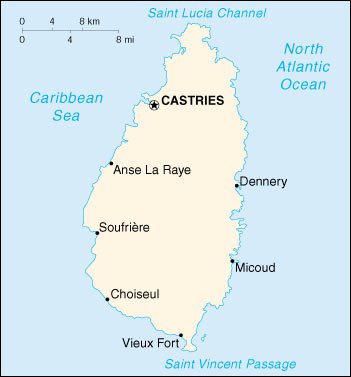Castries, 22 February 2022 (TDI): Today marks the 43rd anniversary of the independence of Saint Lucia obtained in 1979. The independence was obtained from the United Kingdom, and after that, it joined the commonwealth.

Historical Background
St Lucia’s first inhabitants start living there between 1000 and 500 BC by Ciboney, hunters, and gatherers coming from South America. The European settlement goes back to 1500 of this era.
The island was colonized by the French and the British principally. Indeed, the French arrived in the 1500 and then the British in 1605. Even though it took its independence from the British empire, the island still got a french influence. For instance, their language the St Lucia Creole, their family surnames, dance to cite a few.
The British part for its side, left the official language, the educational, and legal system to the country.
Geographical Location
Saint Lucia is an Island state located in the Caribbean sea. It is part of small islands comprised of the Caribbean Windward Islands. The island is 27 miles (43 km) long, and it has over 14 miles (23 Km).
The landscape of the island is formed by a large number of forested mountains and a dense jungle. Around the world, St Lucia is known for the striking twin peaks of Gros Piton and Petit Piton on its southwestern coast.

Regarding rivers, St Lucia is drained by dozen of small rivers. For instance, the largest ones include the Canelles, Cul de sac, Mabouya, and Soufriere.
Political System
Saint Lucia’s political system is a constitutional monarchy. The head of the state is the monarch of the United Kingdom, nowadays Queen Elizabeth. She is represented there by a Governor-General.
It has a bicameral legislature that consists of the House of Assembly representatives and the Senate. The executive body is led by the head of the government, indeed the Prime Minister.
The people of Saint Lucia
Nowadays, the inhabitants of St Lucia are predominantly black or of African descent, and there is a minority of mixed people. Moreover, there are people of East Indian and European descent.
Demographic Trends
The population of St Lucia lives between urban and rural areas. Castries is the city that regroups the majority of the island population. In 2020, the population estimated at 183,671, according to UN data. In addition, the population is quietly young, with a median age of 34.5 years.
Languages of Saint Lucia
In St Lucia, the official language is English. However, the vast majority of its inhabitant speaks Saint Lucia French creole. The St Lucia French creole is used in literature and music, which granted its popularity.
Economic Overview
The economy of the state is based primarily to attract foreign businesses and investment. For instance, offshore banking and tourism industries are the main areas where the economy takes its resources.
Regarding agriculture, Banana is the principal crop of the country. However, Sugarcane was the chief crop until 1964. Moreover, in St Lucia, they produce cassava, spices, yams, coconuts, and more.
St Lucia has a diverse manufacturing producing cardboard cartons, clothing, rum, tobacco products, beer, and more. The major trading partners with which St Lucia trades are the United States, Trinidad, and Tobago, the United Kingdom, Barbados, and Dominica.
National Anthem of Saint Lucia
Sons and daughters of Saint Lucia,
love the land that gave us birth.
Land of beaches, hills, and valleys,
fairest isle of all the earth!
Wheresoever you may roam,
Love, oh love, our island home.
Gone the times when nations battled
For this Helen of the west.
Gone the days when strife and discord
dimmed her children’s toil and rest.
Dawns at last a brighter day,
Stretches out a glad new way.
May the good Lord bless our island,
guard her sons from woe and harm.
May our people live united,
Strong in soul and strong in arm.
Justice, Truth, and Charity,
our ideal forever be!








